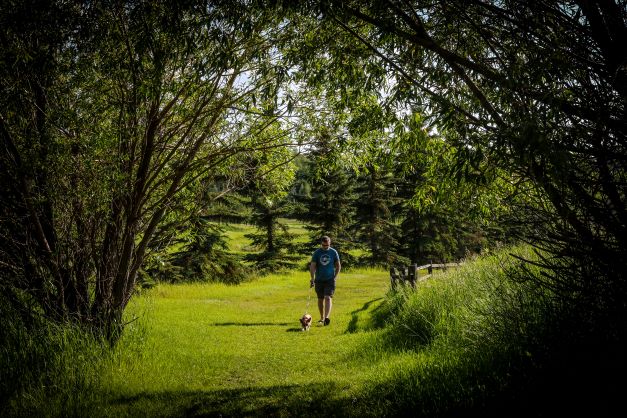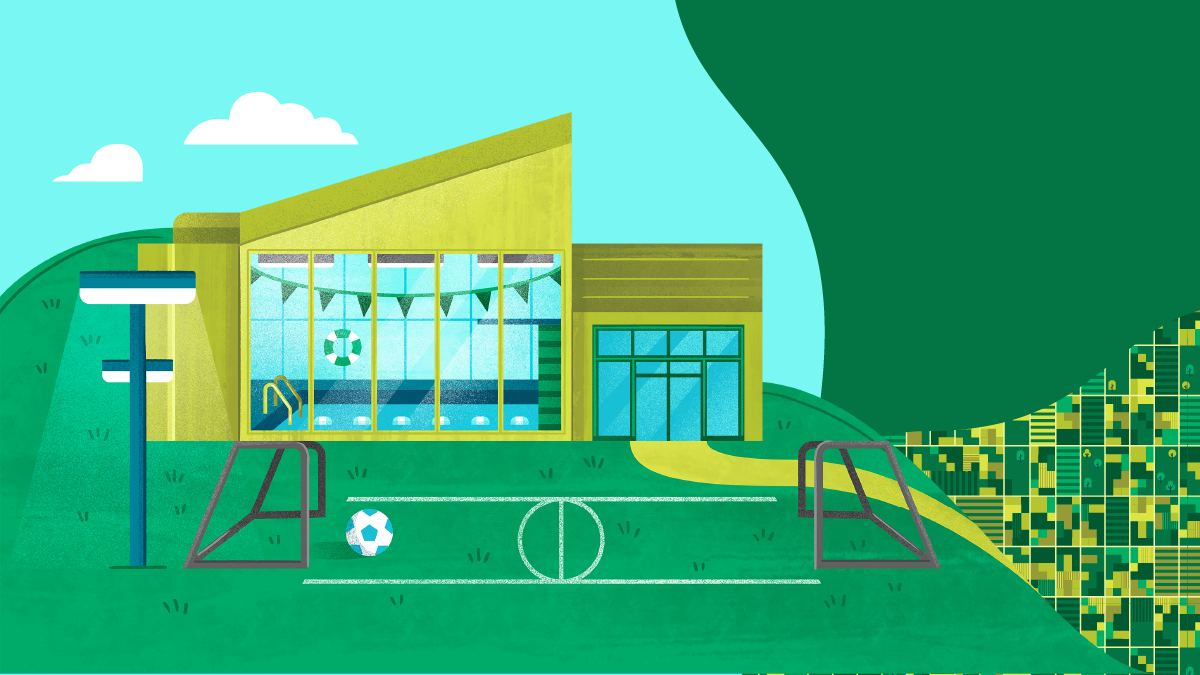3-minute read
Recreational facilities are the heart of many Alberta communities. Municipalities are breathing new life into their recreation facilities with energy-efficient retrofits, benefitting their communities for generations.
Local arenas, aquatic centres, and curling rinks are core gathering places that unite communities through sport, recreation, and other local events. From hockey tournaments, curling bonspiels, trade shows, concerts, and everything in between, these facilities are the heart of Alberta communities.
Recreation facilities are important to communities. It is crucial that they run efficiently and are financially sustainable for decades to come.
The Recreation Energy Conservation Program offers rebates for energy-efficient upgrades that improve indoor heating, lighting and other systems to save energy costs and reduce emissions. Since launching the program in 2019, over 60 municipalities have completed 115 projects that identified energy-saving opportunities and funded efficiency upgrades in recreation facilities.

Over 100 energy efficiency projects in recreation centres across Alberta
Here are some examples of energy-efficient upgrades creating local benefits for municipalities:
LED lighting upgrades
Upgrading lighting with LEDs (light-emitting diodes) is one of the most common energy efficiency retrofits Alberta municipalities are completing in recreation centres. Many recreational facilities are still using fluorescent and metal halide lighting which consume much more energy than LEDs.
LEDs provide a range of benefits compared to traditional lighting technologies including:
- Reduced energy consumption and electrical power demand by producing more light while using less energy. LED upgrades can cut energy consumption and demand by up to 50 per cent.
- LEDs run at lower temperatures making them less prone to failure. This can reduce the amount of maintenance work required.
- LEDs can last over 50,000 hours, much longer than the 15,000 hours of operation expected of metal halide and fluorescent lights.
- Improved light distribution and quality.
- LED lights operate at cooler temperatures, reducing the amount of refrigeration required in ice arenas.
Here’s what Michael Doerksen, Mayor of Drayton Valley said about their latest lighting retrofit at the Omniplex Recreation Centre:
I was very impressed by the outcome. It’s much brighter in here, and I believe the improved visibility will create a safer environment for our skaters. I think our users will be impressed by the difference this retrofit has made to the facility and will add to the user experience”
Mayor Michael Doerksen, Town of Drayton Valley
Tip: Work with a local electrical contractor on the Action Centre’s Lighting Calculator to discover the potential savings and rebate you could receive through the Recreation Energy Conservation program.
Creating high-quality ice
Ice quality is a defining feature of any arena throughout the busy hockey, ringette, and skating season. Maintaining high-quality ice is an energy-intensive process.
Fortunately, new technologies are enabling arena operators to produce and maintain high quality ice with much less energy consumption, resulting in huge cost savings. Two upgrades that produce great ice quality and significant cost savings are de-aerators and electric ice resurfacers.
De-aerators
De-aerators allow operators to use cold water to flood ice surfaces. Typically, the water used to build and resurface ice must be heated to 140-160˚F (60-70˚C) to remove micro gas bubbles before being spread out and frozen to create the ice surface. This process takes a lot of natural gas and compressors use a lot of electricity as they work hard to bring the water temperature down to freezing.
De-aerators extract the micro gas bubbles in less energy-intensive ways and allow cold water to be applied directly to the ice surface. This saves natural gas, electricity, and general wear and tear, while producing a better sheet of dense and fast ice.
Tip: Municipalities located in FortisAlberta service area may apply for Save Energy grants that range from $1,000 – $5,000. These grants can be stacked with funding from the Recreation Energy Conservation program.
Not convinced? Here’s what Bob Young, Mayor of Leduc says about the City of Leduc’s recent REALice (de-aerator) installation at the Leduc Recreation Centre:
“We couldn’t be more excited for this new technology. With the facility shutdown earlier this year, it was a no-brainer to utilize this time to install these devices that will help us save operating dollars after the first year of use. It only made sense to us, and it aligns with our Environmental Sustainability Plan.”
Mayor Bob Young, City of Leduc
Electric ice resurfacers
Traditional ice resurfacers are expensive to operate because of the fuel and maintenance costs expended over their useful life. They also pose health risks associated with exposure to the toxic emissions (such as carbon monoxide and nitrous dioxide) that are released in an enclosed arena during routine ice resurfacing.
With the help of the Action Centre you can replace your fossil-fueled ice resurfacers with an electric solution.
Here are some of the benefits of switching to an electric ice resurfacer:
- Does not use propane or natural gas, only electricity.
- Decreased load on the ventilation system to vent exhaust gases.
- Improved health and safety for guests because of the better air quality.
- Increased fuel and maintenance cost savings.
Here’s what Justin Brunelle, Manager of Fleet Services at City of Medicine Hat had to say about switching to an electric ice resurfacer:
“We are expecting to see significant cost savings by switching to the electric Zambonis. In fuel costs alone, we have estimated that we’ll see savings of up to 80 per cent compared to the gasoline units these are replacing.”
Justin Brunelle, Manager of Fleet Services
Take care of the heart of your community
A review of recreation centres participating in the Action Centre’s Recreation Energy Conservation Program found that the average facility is nearly 40 years old. Some of the oldest recreation centres were built 60 years ago. These facilities are the heart of communities and we need to take care of them for use by future generations.
We reached out to Emily Plilal, the Climate Change Coordinator for several municipalities in the Smoky River region, to hear how she is leading multiple energy-efficient upgrades for both the Guy-Donnelly Arena and the Falher Regional Recreation Complex with funding from the Action Centre.
Here’s Emily’s perspective on the importance of local arenas to the Smoky River region’s community, and how she is improving these facilities through energy-efficient upgrades:
“Both the Falher Regional Recreation Complex and the Guy-Donnelly Sportex are crucial community gathering spots. With only 4,500 people in the Smoky River Region, the facilities provide a spot for people to congregate.
Built in 1986 and expanded in the early 2000s, the Falher Regional Recreation Complex is home to a 24-hour fitness centre, minor hockey teams and a curling league. It also caters to the Town’s Honey festival activities, trade shows, concerts and provides a meeting location for businesses and groups to use.
The Guy-Donnelly Sportex was built in 1978. It is the home to the local figure skating club, many hockey teams, the regional gymnastics club and will also, with improvements set to be completed this year, cater to the high school’s badminton team. It is also utilized as a rental spot for a variety of events.”
What types of energy efficiency projects have been installed at the two arenas?
“Both Falher and Donnelly installed REAL ice de-aerating systems. The de-aerators allow the facilities’ caretakers to make ice out of cold water instead of hot. The Guy-Donnelly Sportex also received funding to replace all lights in the facility. The new LED lights are much brighter and use significantly less energy. “
What motivated the municipalities to pursue energy efficiency upgrades in these facilities and how will this improve the quality of the arena?
“The two municipalities are currently setting targets to reduce their greenhouse gas emissions in line with federal initiatives and recognize the importance of being good stewards of the environment. In addition to environmental concerns, the two municipalities know that making energy efficiency upgrades will save money for their operational budgets. These upgrades will make these facilities usable for the community for generations.”
What role does external funding play in rejuvenating these facilities?
“External funding is critical for small municipalities like us. Many grant programs are far out of reach for small population towns and villages, but these are the municipalities that require most financial assistance. We have a significantly lower tax base to fund programs, facilities and other projects, but still desire to make changes that will benefit residents and also help to protect the environment. External funding is critical to help the facilities operate, maintain and extend the longevity of our operations.
The Recreation Energy Conservation Program from the Municipal Climate Change Action Centre allowed us to reduce our GHG emissions and save substantial amounts of money that will free up extra cash to complete other projects in the facilities.”
GET STARTED
Join the Town of Falher, the Village of Donnelly, and over 60 other municipalities across Alberta that are working to make their arenas more efficient through the Recreation Energy Conservation program.
Municipalities can save up to 100 per cent on costs of scoping audits and engineering studies for recreation centre retrofits and they can save up to 75 per cent on costs of implementing recreation centre retrofits with funding from the Recreation Energy Conservation Program.
Author: Calvin Lechelt, Energy Efficiency Lead


You must be logged in to post a comment.